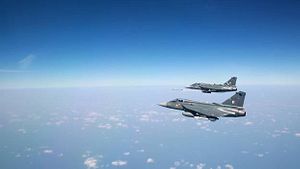The Indian Air Force’s (IAF) Tejas Light Combat Aircraft (LCA) has missed a June 2018 deadline to achieve final operational clearance or becoming fully combat-ready, according to Indian Ministry of Defense (MoD) officials.
The Tejas LCA is a supersonic, single-seat, single-engine multirole light fighter aircraft that has been under development since 1983 by the Aeronautical Development Agency in cooperation with state-owned Hindustan Aeronautics Limited (HAL).
The MoD first announced in 2011 that the Tejas LCA would be combat-ready by 2012. However, six years later the IAF flies 20 (as of December 2017) Tejas LCA in initial operational configuration (the service’s minimum operational requirements).
India’s Aeronautical Development Agency, responsible for the for the fighter jet’s FOC, has so far not publicly commented on the delay.
The IAF placed an initial order for 40 Tejas LCA Mark-I with HAL. Additionally, in December 2017, the IAF issued a tender for the procurement of 83 Tejas LCA. This includes 73 single-engine Tejas LCA Mark-IA and 10 tandem two-seat LCA trainer aircraft.
The IAF has listed several technical deficiencies found on the Tejas LCA Mark-I variant in 2017. These flaws will purportedly will be addressed in later variants of the aircraft, which will include 43 improvements over the existing version.
Upgrades will include an advanced active electronically scanned array (AESA) radar system, a new electronic warfare sensor suite, and a new externally refueling capability.
HAL is in the process of increasing production capacity from eight to 16 aircraft per year, although as of this July, the Indian aircraft maker has so far failed to meet the target of even producing eight Tejas LCA per year.
There are some indications that the Tejas LCA is slowly but steadily inching toward achieving FOC.
In February, the Tejas LCA for the first time conducted a hot refueling trial. “This capability is highly desired in combat situation which basically puts aside the need for the pilot to park the aircraft, power down and exit the cockpit for refueling to begin,” according to HAL.
In April, the aircraft successfully test fired the I-Derby beyond-visual-range (BVR) air-to-air missile at test range off the coast of Goa. “The I-Derby BVR missile has been test fired previously and constitutes the Tejas LCA’s main air-to-air weapon system,” I explained.
“The IAF has also expressed interest in equipping the LCA with an extended-range variant of the I-Derby capable of hitting targets at up to a 100 kilometers distance,” I added.
Tejas LCA also participated in this year’s Gaganshakti-2018 air combat exercise which involved 1,100 aircraft and 15,000 military personnel.
The aircraft now needs to demonstrate its capability for air-to-air refueling as well as engine relighting in flight. The Tejas’ twin-barreled 23 millimeter autocannon will also need to undergo another round of test firing to achieve FOC.
It is unclear whether this will occur before the end of the summer.
































